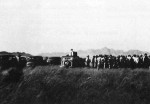Testing the relative variance in ecosystem properties over space and time
The Jornada LTER is organized to test a hypothesis that during desertification the distribution of soil resources changes from spatially homogeneous. as seen in semi-arid grasslands, to spatially heterogeneous. as seen in creosote bush and mesquite shrublands. This vegetation change has occurred during the last 100 years over much of southern New Mexico and West Texas. The change in the spatial distribution of soil resources is reflected by increasing spatial heterogeneity in other aspects of ecosystem function, for instance in the distribution and abundance of higher animals. Long-term studies at the Jornada LTER are designed to test the relative variance in ecosystem properties over space and time.
Using a set of 15 permanent plots for studies of net primary productivity (NPP), Laura Huenneke (New Mexico State University) finds that the mean NPP does not vary between grassland and shrubland communities, but the spatial variation in production is much higher in shrublands than in grasslands. Looking at soil nutrient pools. Ross Virginia (Dartmouth College) has extrapolated data from the permanent plots to provide a landscape-level estimate of the storage of organic carbon in grassland and mesquite shrubland communities.
To a depth of one meter, the pool of carbon in grassland soils is about 5160 g/m. whereas the pool in mesquite ranges from 4320 to 4920 g/m2 depending on cover. He finds that not only the spatial variation of soil C is greater in shrublands. but the total stock of soil C has been reduced as a result of desertification. Working as a postdoctoral associate of William Schlesinger (Duke University). Antonio Gallardo finds that the amount of soil microbial biomass is increasingly limited by the availability of organic carbon in recently desertified habitats.
Soils of the Jornada Basin are also the source of a variety of trace nitrogen gases to the atmosphere. Nitric oxide (NO) and nitrous oxide (N20) are lost as byproducts of nitrification and denitrification. Anne Hartley (Duke University) finds that the emission of NO is relatively low when soils are dry, but it increases by a factor of 41 within 10 minutes after the application of a simulated rainstorm to creosote bush soil. Earlier work by Bill Peterjohn (Duke University) also showed a dramatic increase in soil microbal activity upon the wetting of dry soils.
Walt Whitford (NMSU and EPA, Las Vegas) finds evidence that jackrabbit populations are higher in grasslands than in shrublands. By deep-rooting, shrubs have year-round access to soil moisture, and rabbits can extract this moisture by browsing stems. The original semi-arid grassland communities did not provide an equivalent source of moisture during drought periods. Thus, shrublands are spatially more variable, but temporally less variable, from the point of view of NPP and the herbivore populations that the plants support.
Modeling efforts underway at the Jornada include both “patch” models of local processes and landscape models of basin-wide properties. Initial model simulations run by Jim Reynolds (Duke University) and his coworkers confirm that shrubland NPP is less variable temporally than grassland NPP, except for plant reproductive effort. Within the next year, we hope to extend these models to predict the spatial and temporal distribution of NPP and nitrogen cycling on the Jornada landscape as a function of the pathways and seasonal distribution of overland flow.
For more information: William H. Schlesinger, Departments of Botany and Geology, Duke University. Durham, NC 27706, 919-684-5412, dcalic@dukevm.

 Enlarge this image
Enlarge this image
